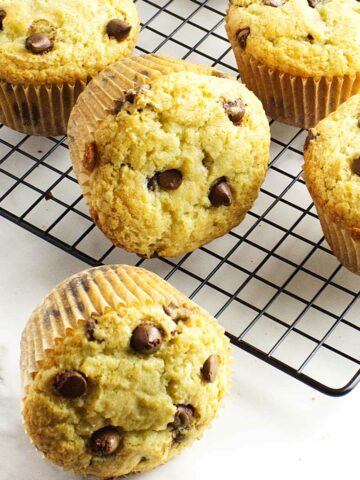Biga (pronounced bee-gah) is an Italian secret weapon in the arsenal of artisan bakers. This pre-fermentation technique, also known as pâte fermentée in France, involves creating a small dough starter with a long, slow fermentation.
The resulting biga adds depth of flavor, improved texture, and a longer shelf life to pizza doughs, ciabatta, and other Italian breads you love.

Why This Recipe Works
This post dives into the wonderful world of biga, explaining its uses, benefits, and even includes a simple recipe to get you started on creating your own biga at home!
- Unlocks Bread Flavor: The extended fermentation in biga allows for the development of complex flavors and aromas, enriching your final bread.
- Improves Bread Texture: Biga contributes to a slightly denser and chewier crumb compared to straight dough, perfect for holding spreads and toppings.
- Simple Technique: Requires minimal ingredients and hands-on time, making biga a beginner-friendly pre-ferment.
Jump to:
Ingredients
This easy recipe relies on just three key ingredients:
- All-Purpose Flour: Provides the structure for the preferment.
- Water: Activates the yeast and creates the dough base.
- Instant Yeast: A small amount of yeast jumpstarts the fermentation process.
Full ingredient amounts and preparation instructions are in the printable recipe card at the bottom of this post.
How To Make A Biga
- In a large bowl, whisk together the flour, water, and yeast until a shaggy dough forms.
- Cover the bowl loosely with plastic wrap and let the dough rest at room temperature (around 70°F/21°C) for at least 12 hours, but preferably 16-18 hours.
- During this time, the biga will rise slightly, become bubbly, and develop a slightly sour aroma.
- It's ready to be used in your bread recipe. You can use it immediately or store it in the refrigerator for up to 3 days.



Substitutions and Variations
Here are a few substitutions or variations you can make when making this Italian preferment.
- Bread Flour: Bread flour can be used instead of all-purpose flour for a biga with a slightly higher gluten content, potentially leading to a chewier final bread.
- Active Dry Yeast: You can substitute active dry yeast for instant yeast. If using active dry yeast, proof it in warm water (around 105°F/41°C) for 5 minutes before incorporating it into the mixture.
Tips for Success
Here are a few tips for making this preferment:
- Use cool water to create a slow and controlled fermentation.
- Be patient! The long fermentation time is key to developing the flavor.
- The fermentation time can vary depending on room temperature. It's ready when it has doubled in size and is full of bubbles.
How A Biga Is Used
Biga is incorporated into the main dough recipe, typically at a percentage of the total flour weight used.
The biga provides a base of active yeast and fermented flour, kickstarting the fermentation process in your main dough and leading to the benefits mentioned above.
Biga is a versatile ingredient used in a variety of Italian-style breads. Here are a few ideas:
- Ciabatta: A classic Italian bread with a light and airy crumb and a crispy crust.
- Focaccia: A flatbread often topped with olive oil, herbs, and sea salt.
- Pane Pugliese: A rustic Italian bread with a chewy texture and a characteristic "ear."

Related Recipes
Equipment
Equipment can have a big impact on how a recipe turns out. Below are some of my favorite pieces of equipment that I use when making this recipe.
Storage and Reheating
- You can store the biga in an airtight container in the refrigerator for up to 3 days.
- Be sure to revive the preferment before using it by letting it sit at room temperature for a few hours.
Frequently Asked Questions
While both involve fermentation, biga uses commercial yeast for a shorter fermentation. Sourdough starters rely on naturally occurring yeast and bacteria captured from the air, requiring a longer maturation period.
The amount of used can vary depending on the recipe and desired results. Typically, a recipe will call for a specific weight or percentage of the total flour in the recipe used for the biga.
Yes, you can substitute active dry yeast for instant yeast. You'll need to activate the dry yeast first. Combine the yeast with warm water (around 105°F/41°C) and a pinch of sugar and let it sit for 5-10 minutes until foamy before using it in the biga recipe.
Biga can be stored in the refrigerator for up to 3 days. The cold temperature slows down the fermentation process significantly. Bring the biga back to room temperature before using it in your main dough recipe.
More Bread Ideas
What Is A Biga?
Ingredients
- 1 cup All-purpose flour
- ½ cup Water (cool or room temperature)
- ½ teaspoon Instant yeast
Instructions
- In a large bowl, whisk together the flour, water, and yeast until a shaggy dough forms.1 cup All-purpose flour, ½ cup Water, ½ teaspoon Instant yeast
- Cover the bowl loosely with plastic wrap and let the dough rest at room temperature (around 70°F/21°C) for at least 12 hours, but preferably 16-18 hours.
- During this time, the biga will rise slightly, become bubbly, and develop a slightly sour aroma.
- It's ready to be used in your bread recipe. You can use it immediately or store it in the refrigerator for up to 3 days.
Notes
- Use cool or room temperature water for optimal yeast activity.
- Ensure your bowl is large enough to allow the biga to double in size during fermentation.
- The fermentation time can vary depending on room temperature. The biga is ready when it has doubled in size and is full of bubbles.










Leave a Reply